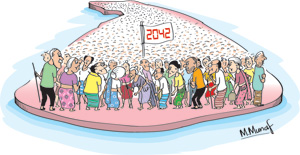Columns
Latest population projection of 25 million poses serious challenges
View(s):The most recent population projections expect the Island’s population to reach 25 million by 2042 and 25.8 million by 2062. It is expected to stabilise around the mid 2060s at 25-26 million. This is a significant departure from earlier projections that expected population stability much earlier at around 23-24 million in the 2030s and to decline thereafter.
This higher population growth that is mainly due to the recent increase in fertility from below replacement level to above replacement level, poses serious social and economic challenges in education, health, care of the elderly, public finances and retirement benefits.
 Twenty Five million
Twenty Five million
Prof. Indralal de Silva’s and Dr. Ranjith de Silva’s recent book, Sri Lanka: 25 Million People and Implications, Population and Housing Projections 2012-2062, presents comprehensive population projections for 2012-2062 incorporating the latest information revealed in the Census of Population and Housing 2012. These expect population growth to be higher than experienced in recent years.
Projected population increase
This standard population projection of the authors projects that the population would reach 21.3 million in 2017, 22.2 million by 2022, 25 million by 2042 and 25.8 million by 2062. The population reaches stability around the mid 2060s at 25-26 million.
This population projection is a significant departure from earlier projections that expected population stability much earlier at around 23-24 million in the 2030s and then begin to decline. This revision is mainly due to the increase in fertility from below replacement level to above replacement level in the past ten years.
 Fertility
Fertility
The revised population projections are different to those made several years ago since fertility trends have changed recently. The previous projections expected the country’s population to stabilize at around 23 to 24 million in 2025. This was based on the total fertility rate declining to below replacement level of 2.1 and reaching 2.0 in 2010. With the total fertility rate increasing to 2.4 in 2012-13, the population is increasing faster.
Growth of population
Since a large number of women will enter reproductive age in the next few years and the expected total fertility rate would be above the replacement level for some time, there is an in-built momentum for the growth of population in the next three to four decades. However, the rate of population growth will be on a declining trend and a near zero population growth rate would be attained after 2062.
Gender balance
According to the projection the sex ratio would favour females for the next two decades. However due to an expected improvement in male health in the next decade, and the elimination of some factors, such as the war that reduced male life expectancy in the past, male survival rates could improve.
The Sri Lankan population is becoming increasingly feminised. In the aged category, a high proportion is female due to their increased life expectancy compared to males. According to the authors of this book, female life expectancy today exceeds male life-expectancy by a wide margin as a majority of this female elderly category are economically inactive in contrast to males in the same category. This implies increased attention to coping with the increasing female aged dependents.
Migration
The out-migration of females, especially to the Middle East, and the transition from extended to nuclear families has led to inadequate familial care for elderly at home. The government needs to provide social security mechanisms for the increasing female elderly population. As the number of the elderly grows, the higher mortality among them would result in an increase in the crude death rate.
Population pyramid
The shape of Sri Lanka’s population pyramid has been changing rapidly over the years. This pyramid, which had a classical shape in 1981, changed into a pagoda like structure by 2012. During the interim period, the working age population grew significantly. The proportion of children (below 15 years) declined from 35 per cent in 1981 to 25 per cent in 2012. The declining fertility over the years led to the progressive decline in the base of the pyramid.
The number of children is significant when making projections on expenditure on education. This number that was 5.1 million in 2012 will increase to 5.3 million in 2017, remain fairly static for the next ten years, and fall once again to 5.1 million by 2032. Thereafter, it would be on a declining trend and drop to 4.4 million by 2062. This contrasts with earlier predictions of a continuous decline in the child population.
Unenviable predicament
Although this age structure transition was an expected phenomenon with society undergoing the demographic transition, what was unexpected was the increase in fertility that arrested the deckling child dependency. Sri Lanka is now in an unenviable predicament of both child dependency and old age dependency being high in the next few decades.
While the ageing of the population poses serious economic and social challenges, child dependency will not decrease as expected earlier owing to the increasing fertility. The proportion of females would be higher than of males and the labour force would not decline.
Problems and challenges
The new population projections that are different to what was expected earlier have to be taken into account in the planning of health facilities, education and social welfare, particularly the care of the elderly. The ageing population requires the enhancement of medical care for illnesses associated with ageing and the expansion of institutional homes for the elderly. The retirement schemes now in operation are limited in coverage, inadequate to the beneficiaries and a strain on the resources of the pension funds or the government. A total revamping of these schemes to make them more supportive of the elderly, while at the same time financially viable is a serious challenge facing the country. The continuing increase in the child populations means that maternal and child care and primary education will require adequate resources. These critical issues that must be addressed without delay if the country is to avoid severe social strains will be discussed in next Sunday’s column.


Leave a Reply
Post Comment